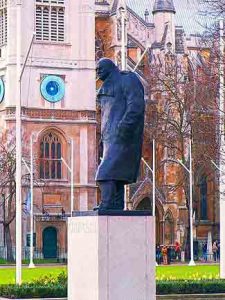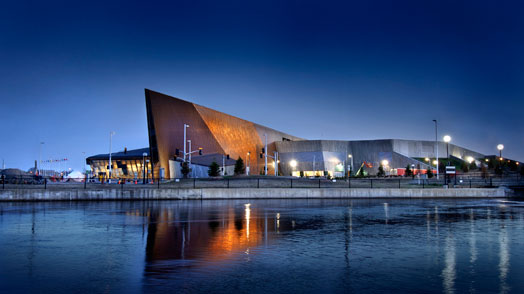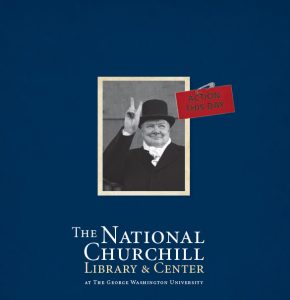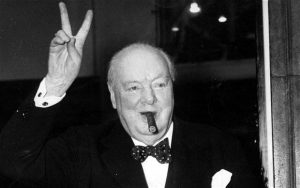
Bulletin #50 - Aug 2012
An Invitation to Visit Ottawa During 29th Annual Churchill Conference in Toronto

August 14, 2012
Sir Winston Churchill Society of Ottawa to host two tours; the Diefenbunker Cold War Museum and the Canadian War Museum. Canadian War Museum, Ottawa, Ontario
Canadian War Museum, Ottawa, Ontario
After this October’s exciting 29th International Churchill Conference in Toronto, attendees are invited to an optional post-Conference visit to the Canadian Capital. As one of the very newest Churchill societies, the Sir Winston Churchill Society of Ottawa (SWCSO) will be delighted to ride the coattails of the Toronto Conference and to welcome you to Ottawa from October 14-16.
The Ottawa program includes a Monday visit to the Diefenbunker, Canada’s Cold War Museum, and one on Tuesday to the Canadian War Museum. Both visits will feature a tour of the Museum, lunch, and expert speakers discussing topics of interest to Churchillians.
You will all undoubtedly be aware that Churchill was a frequent visitor to North America, most frequently on American soil, but more frequently in Canada than any other country outside of his European neighbourhood. While in Canada, he visited Ottawa more times than any other city, six in all. On the first occasion, 112 years ago, he spent Christmas with our Governor General and Lady Minto in Ottawa. On his last visit, almost 54 years later, he met with the Canadian Cabinet and began his broadcast “I have had a lovely welcome from the people of Ottawa.” We wish to extend a similar welcome to those of you who will visit Ottawa after the Conference.
Read the full text of Churchill’s speech in Ottawa here.

2025 International Churchill Conference
Among other things, we are sure that you will want to see our House of Commons, where Churchill 70 years and some months ago triumphantly, and with his adroit sardonicism, revealed his admonition to the French: “When I warned them that Britain would fight alone, whatever they did, their generals told their Prime Minister and his divided cabinet, ‘In three weeks England will have her neck wrung like a chicken.’ Some chicken! Some neck!” In that same House of Commons, the Canadian Prime Minister secretly conspired with Yousuf Karsh to usher Churchill into the Speaker’s Chambers to snap the enduring iconic scowling image of the British Prime Minister (as well as the other photos that grace the cover of the current issue of Finest Hour).

It was in the Library of Parliament that the Churchill Archives Centre displayed the original speaking pages of the Prime Minister’s “Some chicken! Some neck!” address between March and June of this year, enhanced by a video excerpt from that speech, and other published documents. More than 112,000 visitors to the Library of Parliament saw the exhibit. Brochures from the display will of course be available for Ottawa visitors, although the priceless pages are now safely back in the environmental comforts of the Churchill Archives Centre.
Ottawa is a beautiful city, sitting, as so many important cities do, on water, in our case at the confluence of two rivers, the Rideau and the Ottawa. Visitors may stay in the historic 100 year old Château Laurier Hotel, just steps away from the Parliament Buildings, which was home to the Karsh Studio for many years, and where the Karsh Churchill portrait is proudly on display.

The focus and venues for the Ottawa post-conference visit have been selected to augment the theme of the Conference. For these two days, the Churchill Centre and the SWCSO will offer a combination of presentations and visits focusing on the War of 1812 and the Cold War.
On Day 1 (October 15), we will travel to the Diefenbunker, named for Canada’s 13th Prime Minister (1957-63), John Diefenbaker, who ordered its construction in 1959, in order to house key Canadian Government officials in the event of a nuclear attack on Ottawa. The Diefenbunker, which would have been the last thin thread of Government in a nuclear emergency, functioned in that role for 33 years. Built for communication, leadership and the political navigation of international waters during the Cold War, this once-secret bunker is now a museum and a Canadian National Historic Site.
The Diefenbunker is a unique learning environment for present and future generations to better understand one of the most critical times in the world’s history, a time in which conflict was avoided through diplomacy, civil courage and a strong sense of duty. We will be privileged to have Capt (N) (Ret’d) Michael Braham, a leader in civil national emergency preparedness planning with Emergency Preparedness Canada, speaking to us about the leadership role of the Diefenbunker and the structure of nuclear defense in Canada during the Cold War. A special “Cold War” lunch and with award-winning Canadian historian keynote speaker and SWCSO Board member Charlotte Gray delivering a keynote address on the subject of her latest book, the 1890s Klondike Gold Rush, will follow the tour of the unique underground bunker, a true operational relic of the “Cold War”.
On Day 2 (October 16), we will visit the Canadian War Museum. In existence since 1880, when the collection consisted largely of military artifacts, it moved to an old archives building in Canada’s centennial year, 1967. From there, the collection migrated to its magnificent, stunning, dramatically-designed new home, which opened on May 8, 2005, the 60th anniversary of V-E Day. Three of its four chronologically-oriented galleries relate to periods in which Churchill played meaningful (or essential) militarily-related roles, whether as soldier, journalist, First Lord, Minister of Munitions, Secretary of State for War, Minister of Air, Minister of Defence, or Prime Minister.
This year is, of course, the 200th anniversary of the War of 1812, a dramatic event in Canadian and American history that ultimately determined the political boundaries of North America. Few of us know in this anniversary year what was at stake, and who won. A major exhibition at the Canadian War Museum reveals that the answer to these questions depends on perspective. The special exhibition “1812” explores the war through the eyes of the four main participants: Canadians, Americans, the British, and Native Peoples.
For Canadians, the War of 1812 was a successful fight for survival against American invasions. For Americans, the war was a successful defence against the British Empire, and one that forced Britain to respect American sovereignty and power. For the British, the conflict was a successful but almost irrelevant sideshow, scarcely remembered today, to the generation-long war against Revolutionary and Napoleonic France. For Native Americans, the war was a desperate fight for freedom and independence as they struggled to defend their homelands, and its conclusion was a catastrophic defeat.
Dr. Peter MacLeod, the pre-Confederation historian at the Canadian War Museum and curator of the War of 1812 display, will first explain how the War Museum developed the “Four Wars of 1812” concept that underlies the exhibition and then describe how this intellectual concept was translated into a tangible exhibition by using a series of slides of “1812” in various stages of development.
Our lunchtime keynote speaker will be Dr. Andrew Burtch, historian for the Post-1945 period at the Canadian War Museum, who will explain the evolution of Canada’s Cold War civil defence policies and the creation of its civil defence organization to prepare Canadians for a possible nuclear attack. A key element to the success of the program was the persuasion of the public to incorporate the principles of preparation into everyday life. Through exhibits, exercises, and public appeals, Canada’s civil defences agencies exhorted citizens to volunteer as air raid wardens, to stockpile supplies, and to build fallout shelters to wait out the nuclear storm. Dr. Burtch will explain all of this and address the reasons for the failure of the program.
_______________
All Conference attendees are enthusiastically invited to visit Ottawa after Toronto, and may sign up for either Monday’s event at the Diefenbunker or Tuesday’s event at the Canadian War Museum, or both. Local SWCSO members will be delighted to meet you and show you around our home city. And the food and ambience of Ottawa and its French-Canadian neighbouring city Gatineau five minutes away, across the bridge, are undeniably attractive and accessible.
Anyone interested in visiting Ottawa and in signing up for either or both events should contact SWCSO Director and Treasurer Alan Boyce [email protected], who will be pleased to answer all your questions and provide details regarding costs of the two tours.
Ronald I. Cohen
President
Sir Winston Churchill Society of Ottawa
[email protected]
Subscribe
WANT MORE?
Get the Churchill Bulletin delivered to your inbox once a month.





